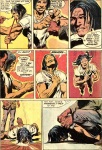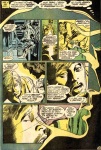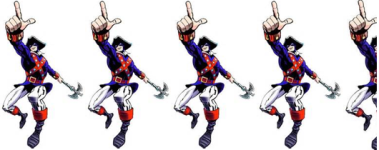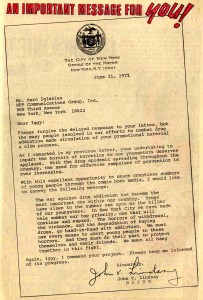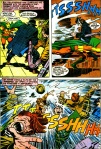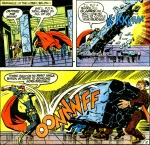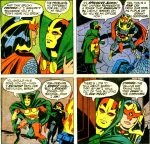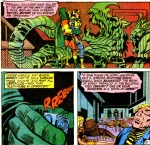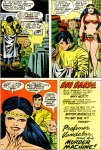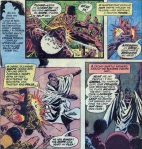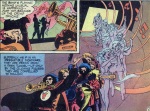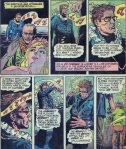
Welcome to another edition of Into the Bronze Age! The world seems quite intent on falling to pieces around us, but let’s take a little time to look back at a simpler era and a better class of comic. The big news in this edition is the finale of the (in)famous GL/GA drug story, but we’ve got a couple of other interesting books to keep that one company.
- Action Comics #405
- Adventure Comics #411
- Detective Comics #416
- Green Lantern/Green Arrow #86
- Mr. Miracle #4
- Phantom Strange #15
- Superboy #178
- Superman #243
- Superman’s Girlfriend, Lois Lane #115
- Superman’s Pal, Jimmy Olsen #142
- Teen Titans #35
Bolded entries are covered in this post, the others will be covered soon.
Green Lantern/Green Arrow #86

“They Say It’ll Kill Me… But They Won’t Say When”
Writer: Dennis O’Neil
Penciler: Neal Adams
Inker: Dick Giordano
Letterer: John Costanza
Editor: Julius Schwartz
That’s right, at long last (longer because of my travels and distractions!) we come to the end of the GA/GL drug two-parter. It’s a famous issue, and we examined why with the first one. As we saw, these issues certainly deserve their iconic status, whatever flaws they may have, and I was surprised by how much better the first issue was than I remembered. I was in for a similar shock with this story, which is a much more even-keeled offering than its predecessor. We don’t have as many heavy-handed and goofy moments here as we did in the last one. Even the cover has a touch more dignity…which is not to say it isn’t a bit over the top as well. In fact, it is wonderfully, ridiculously melodramatic, especially with its bold tag-line. I love Green Lantern’s ‘curse the heavens’ pose as well. Still, it is effective, striking, and memorable, especially with the faces of the various drug victims making up the background.
Unfortunately, the touching image of Green Arrow carrying the fallen form of his ward isn’t quite what greets us inside, where things start off with a bang…or more accurately, a backhand. Ollie follows up Roy’s dramatic confession from last issue with a smack to the face and a heavy dose of vitriol. It’s a really stunning moment, and O’Neil hits us with it right out of the gate. To see a hero, in his right mind, treat a faltering friend like this in 1971 was practically unprecedented. It serve’s O’Neil’s purpose, immediately casting the Emerald Archer’s merciless dismissal of his surrogate son’s suffering in the worst light. Unfortunately, he overplays his hand once more, and the result is a further stain on Ollie’s already fairly blackened character, though it is consistent with the strong views he evinced in the last issue. It’s just an ugly moment, not helped by the fact that Roy isn’t at his most sympathetic after his weak story last issue.
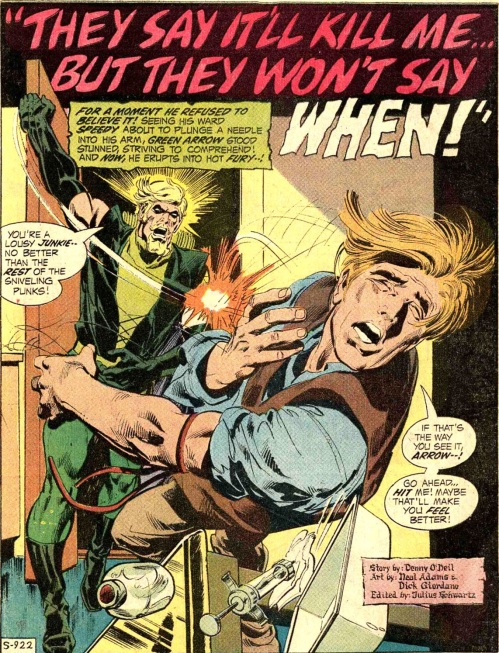
Speedy mocks his mentor for his violent response, hitting him with a major guilt trip, and Arrow throws the kid out. 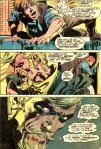 Then we get a moment which ALMOST addresses some of the flaws of the previous story, as the Battling Bowman ponders the situation and points out that, even though he hadn’t paid his ward much attention lately, the kid shouldn’t have needed much at his age, being in college and all. Then O’Neil once again turns Ollie’s jerk dial to 11, as, from that, he concludes that he is completely “innocent of blame,” which is a self-righteousness and self-deception that is breathtaking, even for O’Neil’s Green Arrow. Still, in all of this melodrama, there is some realism.
Then we get a moment which ALMOST addresses some of the flaws of the previous story, as the Battling Bowman ponders the situation and points out that, even though he hadn’t paid his ward much attention lately, the kid shouldn’t have needed much at his age, being in college and all. Then O’Neil once again turns Ollie’s jerk dial to 11, as, from that, he concludes that he is completely “innocent of blame,” which is a self-righteousness and self-deception that is breathtaking, even for O’Neil’s Green Arrow. Still, in all of this melodrama, there is some realism.
After concluding that he’s father of the year after all, the Emerald Archer sets out to take revenge on the pushers who he blames instead, heading to the airfield where he previously traced their supply to pick the investigation back up. Meanwhile the two junkies who betrayed our heroes last issue come to Ollie’s place looking for Speedy and, not finding him, decide to shoot up their reward. The drugs are pure, and one of them overdoses in what is, admittedly, a pretty good scene, though Adams perhaps overdoes the revelation a bit.
Later, we find Hal Jordan still running through previous events, unable to shake the feeling that there is something wrong with Speedy, and when he heads to GA’s to check on the kid, he finds the junkie and begins his own investigation. Ollie, for his part, turns the table on a guard at the airport who gets the drop on him and is sent into a trap for his troubles. It’s a nice scene, emphasizing both his anger and his skill, that he’s still dangerous, even with a busted wing.
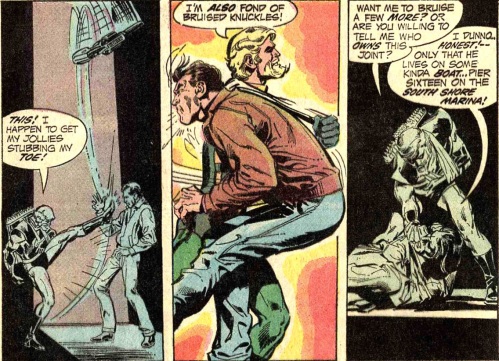
In the meantime, the Emerald Gladiator finds Speedy passed out in an alley and discovers the truth. They have an almost decent conversation, though O’Neil overdoes the youth’s rhetoric a bit. The generation gap stuff he spouts is a little problematic given the fact that most of the members of the previous generation Roy knows are freaking paragons of virtue. Nonetheless, Hal’s measured response and kindness is a very pleasant departure from his stupidity and naivete from early in the run. The ring-slinger takes the kid to Dinah’s house for sanctuary.
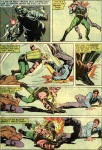 On the docks, where the Battling Bowman has followed the guard’s tip into trouble, he finds the thugs he tangled with at the airport last issue. We get a nice fight scene, with Arrow still holding his own, but it ends with him getting knocked out. When he comes to, we meet the man behind the drug operation, a wealthy socialite named Saloman, whose massive yacht, stuffed full of important people, is just leaving. He tells his men to dump the antagonistic archer into the drink as soon as he’s away.
On the docks, where the Battling Bowman has followed the guard’s tip into trouble, he finds the thugs he tangled with at the airport last issue. We get a nice fight scene, with Arrow still holding his own, but it ends with him getting knocked out. When he comes to, we meet the man behind the drug operation, a wealthy socialite named Saloman, whose massive yacht, stuffed full of important people, is just leaving. He tells his men to dump the antagonistic archer into the drink as soon as he’s away.
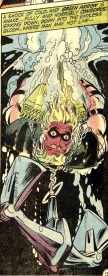
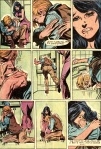 Adams gives us a fantastic image of Ollie’s plight, as he’s tossed overboard tied to an anchor, but the hero manages to grab an acetylene arrow and cut through the chains, making a desperate and dramatic escape. Just then, the Lantern arrives and disposes of the thugs with some green gorillas. As they pursue the head honcho, Speedy is busy going through withdrawals, aided by Black Canary’s quiet compassion in another good sequence, improved by a lack of dialog.
Adams gives us a fantastic image of Ollie’s plight, as he’s tossed overboard tied to an anchor, but the hero manages to grab an acetylene arrow and cut through the chains, making a desperate and dramatic escape. Just then, the Lantern arrives and disposes of the thugs with some green gorillas. As they pursue the head honcho, Speedy is busy going through withdrawals, aided by Black Canary’s quiet compassion in another good sequence, improved by a lack of dialog.
In the Caribbean, Saloman Hooper visits his pharmaceutical lab, where he picks up a suitcase worth of dope (which doesn’t seem like enough to justify the scope of his operation), only to be caught in the act by the Green Team. While Ollie takes out the mogul’s minion with a one-armed arrow shot (shades of Dark Knight Returns!), Hal tosses his friend his ring in order to deal with Hooper with his own two hands. This is actually a pretty believable, satisfying moment, unlike the book’s tendency to have the Lantern just decide that he needs to use his fists to feel like a man. He’s angry, and he takes it out on this privileged punk, but he has enough self control to do it ‘unofficially,’ so to speak, like a cop putting aside his badge to do something that needs doing but which falls outside of the law. Notably, Arrow calls him on this afterward.
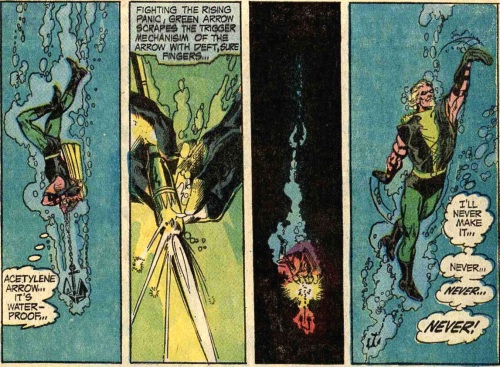
The issue ends with the funeral of the junkie who overdosed, where Hal and Ollie are joined by Dinah and a recovered Roy. Unfortunately, the newly clean Titan is in no mood to mend fences, and he lashes out at his former guardian, giving a speech about how people like him, who lack compassion, are contributing to the crisis that so many young people face. As Speedy walks away from the closest thing to family that he has, Green Arrow finds himself proud that the boy has become a man.
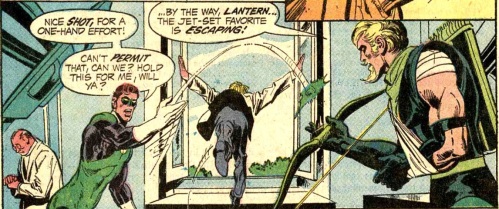
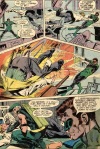 That final scene isn’t as heavy-handed as I remember, though the melodrama still sets my teeth on edge a bit. What’s worse, it leaves the situation between our hero and his surrogate son unresolved and embittered. That’s a shame, and this story’s consequences will be deep and long-felt. On the whole though, this is actually quite a good issue, sensitive and perceptive, but also an engaging and exciting adventure, with some real, if sometimes discordant, character development to go with it.
That final scene isn’t as heavy-handed as I remember, though the melodrama still sets my teeth on edge a bit. What’s worse, it leaves the situation between our hero and his surrogate son unresolved and embittered. That’s a shame, and this story’s consequences will be deep and long-felt. On the whole though, this is actually quite a good issue, sensitive and perceptive, but also an engaging and exciting adventure, with some real, if sometimes discordant, character development to go with it.  Once again, the message of compassion and understanding towards drug addicts is powerful, and the theme of empathy, learning to see things from someone else’s perspective, is effective and an interesting continuation of O’Neil’s better efforts in this run. I think the story itself would have been a bit more effective if we had met our villain a bit earlier, as he’s mostly just a convenient and morally acceptable punching bag, an outlet for outrage and despair. Still, O’Neil manages to make the guy loathsome in very little space. Roy’s sudden and complete recovery is more than a little silly, in regards to the reality of addiction, but I suppose allowances can be made for the medium.
Once again, the message of compassion and understanding towards drug addicts is powerful, and the theme of empathy, learning to see things from someone else’s perspective, is effective and an interesting continuation of O’Neil’s better efforts in this run. I think the story itself would have been a bit more effective if we had met our villain a bit earlier, as he’s mostly just a convenient and morally acceptable punching bag, an outlet for outrage and despair. Still, O’Neil manages to make the guy loathsome in very little space. Roy’s sudden and complete recovery is more than a little silly, in regards to the reality of addiction, but I suppose allowances can be made for the medium.
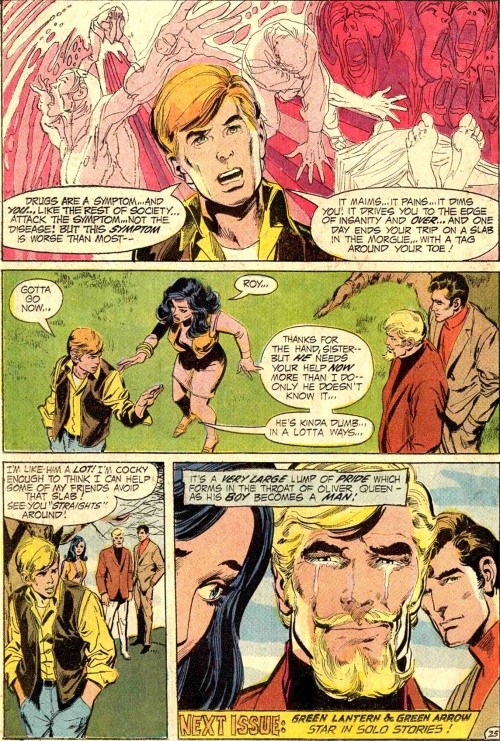
Adams’ art continues to be beautiful and compelling, really capturing the emotion and the power of the moments he portrays. And yet, even with that focus on drama, he manages to give us some fun and funny moments, like with Ollie’s expression during his impromptu dive. Once again, we see Adams’ power with a more intimate, personal story. I just love his portrayal of Ollie. Characters of that scale are really what he excels at, which is part of why his Batman run is so legendary. All in all, this is a very good story, only slightly damaged by O’Neil’s excesses and his lack of forethought. It is an important comic, culturally, and its themes and subject were incredibly groundbreaking in its time. Heck, we’re still fighting some of these battles, and a story that reminds us of the humanity of those who are suffering is still relevant, perhaps moreso these days than in recent years. I’ll give this milestone issue 4.5 Minutemen out of 5. It isn’t perfect, but it really is a good one.
P.S.: To mark just how important his comic book was, it carries a copy of a letter from the Mayor of New York, commending the creative team for their work and pointing out the seriousness of the drug crisis.
Mister Miracle #4
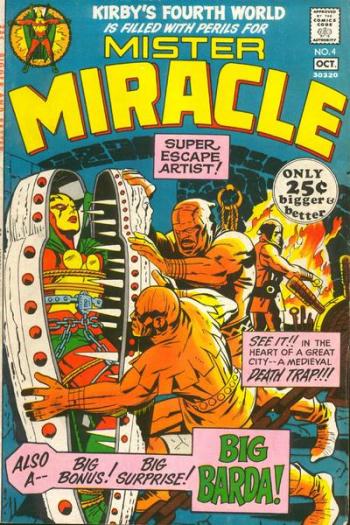
“The Closing Jaws of Death!”
Writer: Jack Kirby
Penciler: Jack Kirby
Inker: Vince Colletta
Editor: Jack Kirby
“The Romance of Rip Carter”
Writers: Jack Kirby and Joe Simon
Penciler: Jack Kirby
Inker: Joe Simon
“Jean Lafitte: ‘Pirate or Patriot?'”
Writer: Jack Kirby
Penciler: Jack Kirby
Inker: Jack Kirby
We’ve got another marvel-packed issue of Mister Miracle here, and, as always, I was excited to read it, especially after the pulse-pounding excitement of last issue’s Paranoid-packed pandemonium. Sadly, this one doesn’t quite live up to the thrill of the first half, though it does introduce us to a wonderful character and an important part of Scott Free’s supporting cast. It’s got another great cover, like most of this series, though one wonders how our escape-artist hero gets from being locked in a trunk to tortured in a medieval dungeon. The answer is, of course, Kirby madness. Nonetheless, we get another death-defying scene in this cover, memorable and exciting, beautifully rendered by the King.
Inside, we don’t start with the miraculous one plummeting to his death, still locked in that suitcase, but back at his home, where a fretting Oberon finds himself with an uninvited guest. A fierce and outlandishly armored warrior woman appears behind him, jarring the loyal fellow from his reverie rather violently. She declares herself a friend of Scott Free and demands to know where he is, mentioning they both come from Apokolips. When Oberon mentions Doctor Bedlam, the newly introduced Barda suddenly teleports after her friend, fearing for his life.
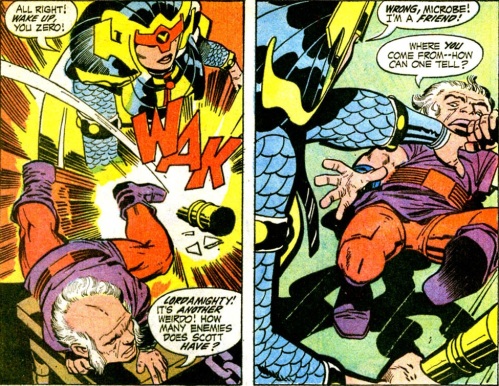
Now we pick up where we left off, and Scott’s situation looks hopeless, but Barda appears in a flash of light and catches his suitcase in a feat of strength, casually ripping it apart, ropes and all, only to reveal that it is…empty! Wonderfully, we don’t see how the eminent escape artist pulled off this trick just yet; instead, we see him perched on a balcony several floors up, where he is quickly swarmed by more crazed civilians. They think he is a vampire and attempt to stake him, but Mr. Miracle is too slick for them, and eludes his pursuers in several fun pages, even sliding down the banister of the staircase like Errol Flynn.
 Suddenly, he’s attacked by refugees from a Robin Hood picture, as a bunch of guys in medieval costumes capture the hero. They drag him into a dungeon, which turns out to be a set in the Galaxy Broadcasting TV studio, conveniently located on this level. Inside is a director, even nuttier than most, who directs his men to kill the interloper so that his death-throes can make for good television! Despite his struggles, Scott is forced into an iron maiden, and all seems lost as the lid slams shut. The whole scene is fun but utterly crazy. It reads like a Fantastic Four issue from the era where Stan and Jack weren’t talking to each other and Stan was thrown into narrative gymnastics in an attempt to explain the bizarre and unrelated images Jack created as his imagination ran away with him. However, this time, there’s nobody to blame for the sudden shift and strange explanation other than Kirby himself. I guess he just wanted to draw an iron maiden, so he shoe-horned the setting in, logic be darned!
Suddenly, he’s attacked by refugees from a Robin Hood picture, as a bunch of guys in medieval costumes capture the hero. They drag him into a dungeon, which turns out to be a set in the Galaxy Broadcasting TV studio, conveniently located on this level. Inside is a director, even nuttier than most, who directs his men to kill the interloper so that his death-throes can make for good television! Despite his struggles, Scott is forced into an iron maiden, and all seems lost as the lid slams shut. The whole scene is fun but utterly crazy. It reads like a Fantastic Four issue from the era where Stan and Jack weren’t talking to each other and Stan was thrown into narrative gymnastics in an attempt to explain the bizarre and unrelated images Jack created as his imagination ran away with him. However, this time, there’s nobody to blame for the sudden shift and strange explanation other than Kirby himself. I guess he just wanted to draw an iron maiden, so he shoe-horned the setting in, logic be darned!

Back in our original office-building setting, Barda is getting attacked herself. She casually rips a stone column out of the lobby and tosses it onto a half dozen men, almost certainly crushing them all to death. Despite Mr. Miracle’s insistence that she stay out of this so that his deal with Bedlam could be honored, she is worried, so she pursues her friend, smashing her way through the overly-excited extras in the process in a really nice panel. Yet, when she pries open the torture device, it is empty, and Scott casually strolls up and greets her. Once again, we don’t find out how he accomplished this yet, establishing a running joke in the issue.
The two press on, confronting the disembodied energy-form of their antagonist in another nice sequence. Bedlam promises to unleash the entire fury of the building’s trapped inhabitants upon the pair, but the next thing we see is them teleport back home, greeting a worried Oberon and catching up. The dialog in this section is pretty rough and stilted, especially when Scott awkwardly declares: “Maximum is the word for you, Barda! I could never think of you without deep and genuine fondness.” I know that line just makes the ladies swoon! From the start, Barda and Oberon are sparring verbally which, despite the dull dialog, is still fun. We learn that Barda helped her friend escape, but she didn’t go with him, and now she’s an officer in Darkseid’s Female Furies, as everyone helpfully spouts exposition.
In a fun little scene, Scott takes the domestic roll, preparing dinner for Barda, which is really striking in a comic from 1971. That’s honestly somewhat groundbreaking. I doubt you’d ever see Superman making dinner for Lois Lane! It also establishes the unusual dynamic between these two characters. As he works, the heroic homemaker reluctantly explains to his assistant how he escaped from the various traps he faced. We’re introduced to the ‘multi-cube’, Scott’s multi-purpose escape tool, which will become a common feature of his stories, if I remember correctly. Mr. Miracle used it to cut his way out of the trunk as it twisted in mid-air, which works pretty well as an explanation.

Unfortunately, the other stories aren’t nearly as good. He used a fast-acting acid on the back of the iron maiden and literally just stepped through it, which apparently no-body noticed. Even more problematic, he literally presses the ‘off’ button on all of the panicked people in the tower, putting them to sleep with his multi-cube and just waltzing out the front door. Okay……why not just do that in the first place? That’s a pretty massively unsatisfying conclusion, which is a shame, because this is otherwise a really fun issue. The yarn ends with Barda showing up for dinner, having changed out of her armor into something a tad more revealing, leaving Oberon picking his jaw up off the floor.
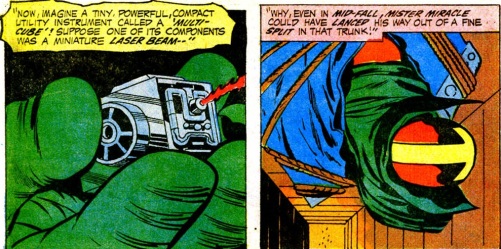
This is a solid adventure, despite its glaring deus ex machina, though it is primarily worthwhile for introducing Big Barda, who will eventually become Scott’s partner and wife, creating one of the great comic relationships and partnerships. Mr. Miracle without Barda is like Nick without Nora, and she is, even from this first appearance, a unique and interesting character, further credit to Kirby’s boundless creativity. In addition, I absolutely love Scott’s laughing, devil-may-care attitude throughout the story, the extra element of flair and style to his antics, which really capture his personality and are part of why I love the character. I also quite like the running gag of not explaining his escapes right away, however flawed the execution is here. Hopefully Kirby will make better use of it in the future.
Art-wise, we’re seeing some rough panels again with this issue, and I think Colletta’s impact is still being felt. On the plus side, it seems we get a new inker next issue! Despite some weaknesses, especially with inking and coloring, there are some wonderful panels and some fun, dynamic sequences throughout. Ultimately, I’m quite torn on the score. This issue’s flaws are significant, especially the dialog and weak conclusion, but it is also a lot of fun. I suppose I’ll be generous and go with 3.5 Minutemen, as the comic is carried along by the interest of Barda and the fun of Scott.

The Phantom Stranger #15
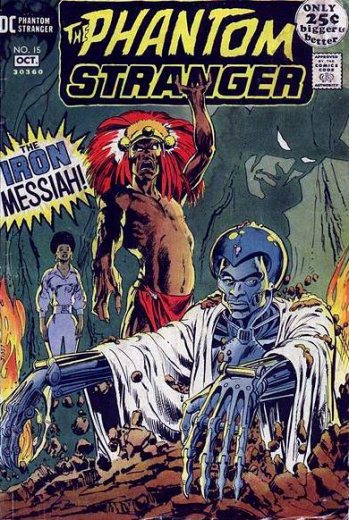
“The Iron Messiah”
Writer: Len Wein
Penciler/Inker: Jim Aparo
Colourist/Letterer: Jim Aparo
Editor: Joe Orlando
Cover Artist: Neal Adams
“I Battled for the Doom Stone”
Writer: Ed Herron
Penciler: Alex Toth
Inker: Alex Toth
“Satan’s Sextet”
Writer: Robert Kanigher
Penciler: Tony DeZuniga
Inker: Tony DeZuniga
“I Scout Earth’s Strangest Secrets”
Writer: Jack Miller
Penciler: Mort Meskin
Inker: Mort Meskin
What a wildly, wonderfully ridiculous cover image. It’s gloriously strange and unusual and so very, very much something that could only happen in comics. 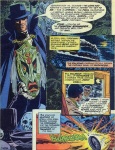 We’ve got an African witch doctor raising a zombie…but not just any zombie, a ROBO-zombie, complete with stainless-steel robo-zombie Afro, all while the shadow of the Phantom Stranger looms in the background. It’s a thing of mad beauty, and I love it. It’s beautifully illustrated by Adams, and it absolutely grabs your attention. Could you honestly say you could see that image on the newsstand and NOT want to figure out what in the blue blazes is happening inside? If so, I can only assume you’re an imagination-less wreck of a human being.
We’ve got an African witch doctor raising a zombie…but not just any zombie, a ROBO-zombie, complete with stainless-steel robo-zombie Afro, all while the shadow of the Phantom Stranger looms in the background. It’s a thing of mad beauty, and I love it. It’s beautifully illustrated by Adams, and it absolutely grabs your attention. Could you honestly say you could see that image on the newsstand and NOT want to figure out what in the blue blazes is happening inside? If so, I can only assume you’re an imagination-less wreck of a human being.
 The story within doesn’t quite live up to the glory of the robo-zombie cover, but then, how could it? It is an interesting and unusual one, though, and it begins, not with necromantic robotics (more’s the pity), but with a young African scientist named John Kweli, who is returning to his native country after having been educated in the West. Suddenly, the train on which he’s traveling derails in a fiery crash, and the brilliant man would have died, if not for a Stranger pulling him from the wreckage. Kewli awakens in the home of an old friend, Ororo (no, not that one). She has treated his injuries, but she also bears bad news, his father, the tribal chief, has died.
The story within doesn’t quite live up to the glory of the robo-zombie cover, but then, how could it? It is an interesting and unusual one, though, and it begins, not with necromantic robotics (more’s the pity), but with a young African scientist named John Kweli, who is returning to his native country after having been educated in the West. Suddenly, the train on which he’s traveling derails in a fiery crash, and the brilliant man would have died, if not for a Stranger pulling him from the wreckage. Kewli awakens in the home of an old friend, Ororo (no, not that one). She has treated his injuries, but she also bears bad news, his father, the tribal chief, has died.
John is prepared to come home and take over his responsibilities as chief, but he’s met with resentment for having gone away to be educated and built a life overseas. His people feel like he abandoned them, including the lovely Ororo. He also finds things greatly changed, with signs of unrest and oppression everywhere, barbed-wire and troops abound. Ngumi, the village shaman also rejects John, promising that Chuma, the Warrior God, will free his people without the young man’s help.
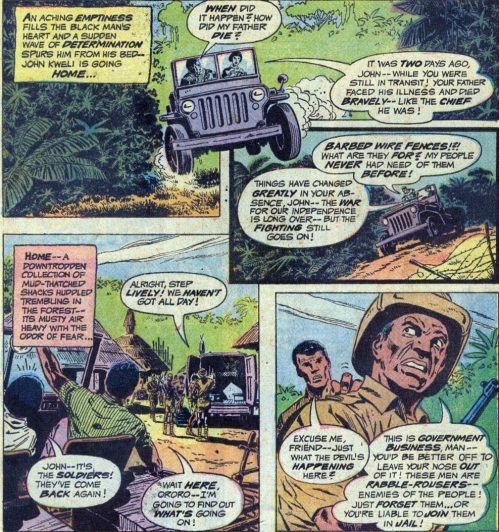
Ororo tells her friend about what has happened in his absence, that though their country has been liberated, they are now enslaved to the interests of big foreign business. Driving away, John and Ororo encounter a lion and wreck their jeep. The young scientist bravely prepares to sacrifice his life to lure the beast away, only to have the Phantom Stranger leap out of nowhere to tackle the feline fiend in magical fashion.

The next day, Kewli goes to visit Amos Trent, the oil company’s man on the ground, but Trent isn’t interested in his pleas or his threats, so the young scientist decides to take matters into his own hands, so of course he builds a robot. Some time later, a group of soldiers who are abusing the villagers are scattered, not by John, but by “Chuma”, the Iron Messiah, the android John has used his scientific skill to build in order to rally his people. Over the next weeks, Chuma trains the villagers in the ways of war, and Ngumi, the shaman is revealed as an agent of the oil company.
Unfortunately, even iron will can be bent by such a burden, and Chuma begins to develop human feelings…and human frailties. He declares his love for Ororo, and when she rejects him, saying she loves his creator instead, the Iron Messiah rejects his role as savior and leaves the people to the fate. It is here that the Phantom Stranger intervenes once again, convincing the automaton that the only way to prove he is a being with a soul is to choose to help his people, to be better than jealousy and spite. Back at the village, the government troops have attacked, and John has rallied the people, but they are losing without the power of Chuma to inspire and aid them.
Chuma charges into the battle, turning the tide, but his help comes at a terrible cost, as he shoots his creator in the back in a fit of jealousy, only to be witnessed and called out by Ororo. The people reject their Iron Messiah and destroy him, thanks again to the Phantom Stranger, who leaves, pondering the enigma that is life and giving a speech about not “tampering in God’s domain.”
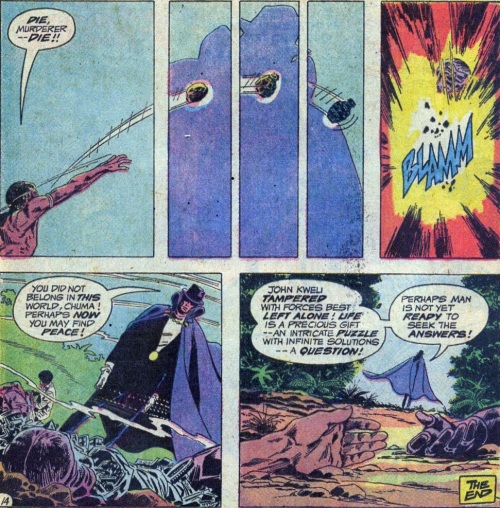
It’s…a little abrupt, really, and rather grim. These 14 pages pack a whole lot in, and Len Wein has a very interesting story to tell…I’m just not entirely sure he’s finished telling it. We get a robot who develops human feelings, including hatred who turns on his creator, a full on Frankenstein, but it is also sharing space with a story about the exploitation of Africa. There’s just too much in too little space. Chuma literally goes from his creation to his renunciation of his purpose in three pages, and John, who has until then been our protagonist, almost drops out of the story at that point. The Stranger’s attempt at a moral just feels extremely tacked on, though it certainly has potential. In the end, what exactly was the point of the Stranger’s intervention? Was it to free the natives from both the outsiders and from their superstitions? Whatever it is, it needs more development. The whole thing is cramped, but it is also intriguing in a number of ways.
It is really noteworthy that we have a story set in ‘darkest Africa’ where the natives are not portrayed as ignorant savages, despite their belief and hope in Chuma. Even more, the natives are not rescued by a white outsider. Instead, the hero is a black man, and a black scientist at that, who succeeds, not through brute force, but through intelligence and cleverness. That’s still very much a rarity in any media in 1971, much more so in comics. We also have another example of the depredations of faceless corporations, as the oil company is pretty unambiguously evil here. That is a sign of things to come, I’d wager.
The whole tale is beautifully illustrated by Aparo, who is handling all of the art chores. He gives us some really striking panels and pages, and the art has a nice sense of drama, especially with Chuma. I’ll give this rushed, slightly muddled story 3 Minutemen, as its strengths and weaknesses somewhat even out.

“Satan’s Sextet”
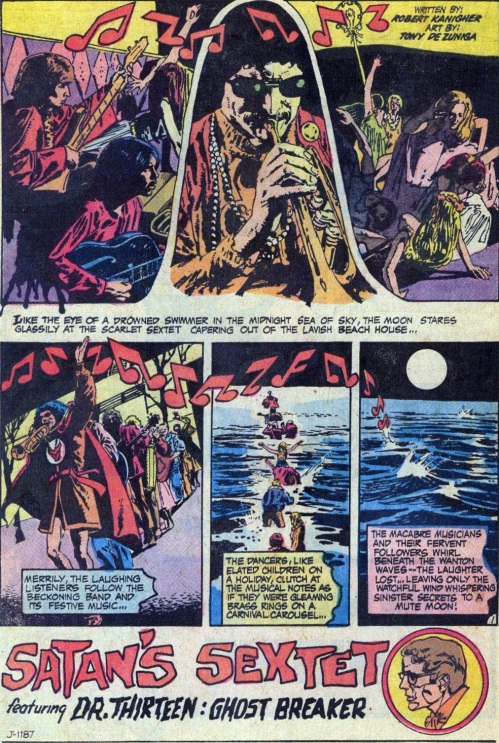
If you thought robo-messiahs were strange, you ain’t seen nothing yet. Our Dr. Thirteen backup this month is in the style that I think works best, with the good Doctor doing his ghost-breaking on his own, without tangling with the Stranger. Nonetheless, this particular outing isn’t exactly a home run. It begins promisingly and strangely enough, with a group of seemingly sinister musicians leading a line of dancers into the sea, where they presumably drown, only for the band to emerge later, still playing. Later that night, Dr. Thirteen happens to be driving along the beach when he sees a ragged, raving figure stumble out of the surf.
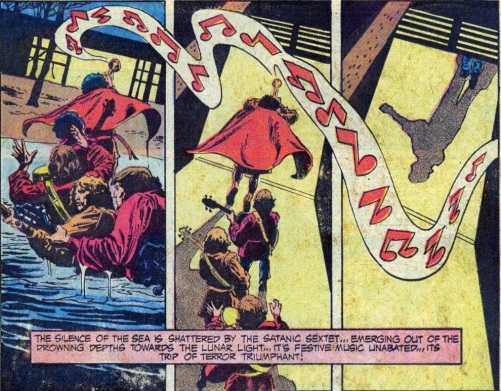
The man claims to be the wealthy Willard Wentworth, who has a home on the beach. He hired “Satan’s Sextet” for a house party because he was lonely, but they hypnotized all of the guests and led them to a watery grave. Wentworth isn’t sure how he escaped, but he stumbled out of the water sometime later, shaken and terrified. Thirteen agrees to investigate, but when they return to the beach house, they find it packed with people, a party in full swing. The owner claims not to know any of them and accuses the band of murder. Dr. Thirteen insists they stay and continue their investigation (Maybe he just wants to party!), and the pair are given love-beads.

Suddenly, the band’s music becomes hypnotic, and they once more lead the party goers into the waves. Thirteen is forced to follow, but his mind is working all the while, and he deduces that the beads are responsible, and he removes his and Wentworth’s necklaces. Returning to the house, he overhears the convenient exposition by the bandleader, whose motives are…well, as prosaic as his methods are insane.
Apparently, he’s the millionaire’s disowned son, who got plastic surgery and planned this whole thing to kill his father so he could get his inheritance. The beads had hallucinogens in them which were activated by the vibrations of the band’s music. Ooookaaaay. That’s pretty out there, even for comics. Entertainingly, Thirteen overcomes the band with a massive mounted fish, and the police arrive to tidy things up. Dr. Thirteen rides off into the sunrise, but not before laying some major guilt on Wentworth, pointing out that he must have really screwed up to raise a murderer! Ouch!

 This is a fun concept that sadly doesn’t really deliver a good story. The image of the Pied-Piper-esq murder is really neat and creepy, but the explanation and the motivations don’t live up to the cleverness of the gimmick. I think this might have worked better as a Phantom Stranger story, with an actual supernatural explanation. Nonetheless, it’s a decent enough read. The sequence where Dr. Thirteen reasons his way to the solution to the mystery is quite solid, and it has a nice sense of suspense and stakes as he slowly drowns. Tony DeZuninga’s art isn’t particularly impressive, but it does the job, though the inking is a bit overdone in some sections. He tries to create a somewhat psychedelic feel to the band’s sections, and that is partially successful. I’ll give the whole thing 2.5 Minutemen.
This is a fun concept that sadly doesn’t really deliver a good story. The image of the Pied-Piper-esq murder is really neat and creepy, but the explanation and the motivations don’t live up to the cleverness of the gimmick. I think this might have worked better as a Phantom Stranger story, with an actual supernatural explanation. Nonetheless, it’s a decent enough read. The sequence where Dr. Thirteen reasons his way to the solution to the mystery is quite solid, and it has a nice sense of suspense and stakes as he slowly drowns. Tony DeZuninga’s art isn’t particularly impressive, but it does the job, though the inking is a bit overdone in some sections. He tries to create a somewhat psychedelic feel to the band’s sections, and that is partially successful. I’ll give the whole thing 2.5 Minutemen.
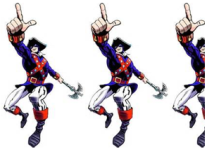
And with those maudlin mysteries, this episode of Into the Bronze Age comes to a close! It was a really interesting trio of books, flaws and all. Thank you for joining me on this journey, and please come back soon for another edition of Into the Bronze Age! Until then, keep the Heroic Ideal alive!
